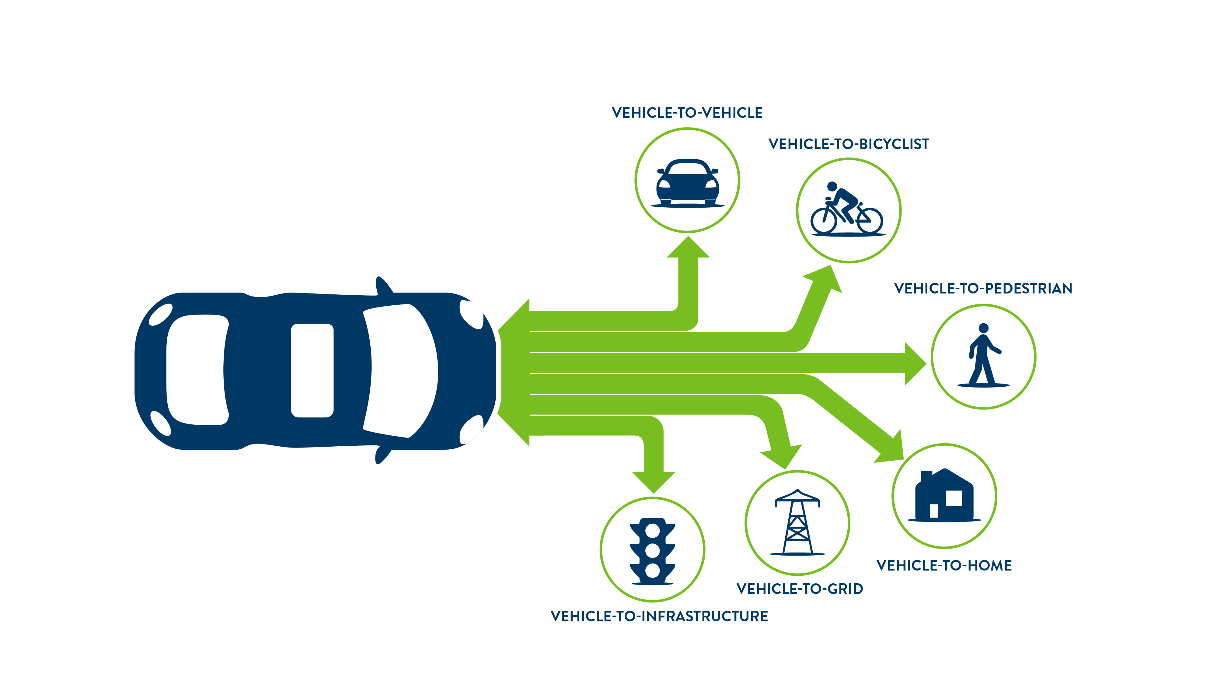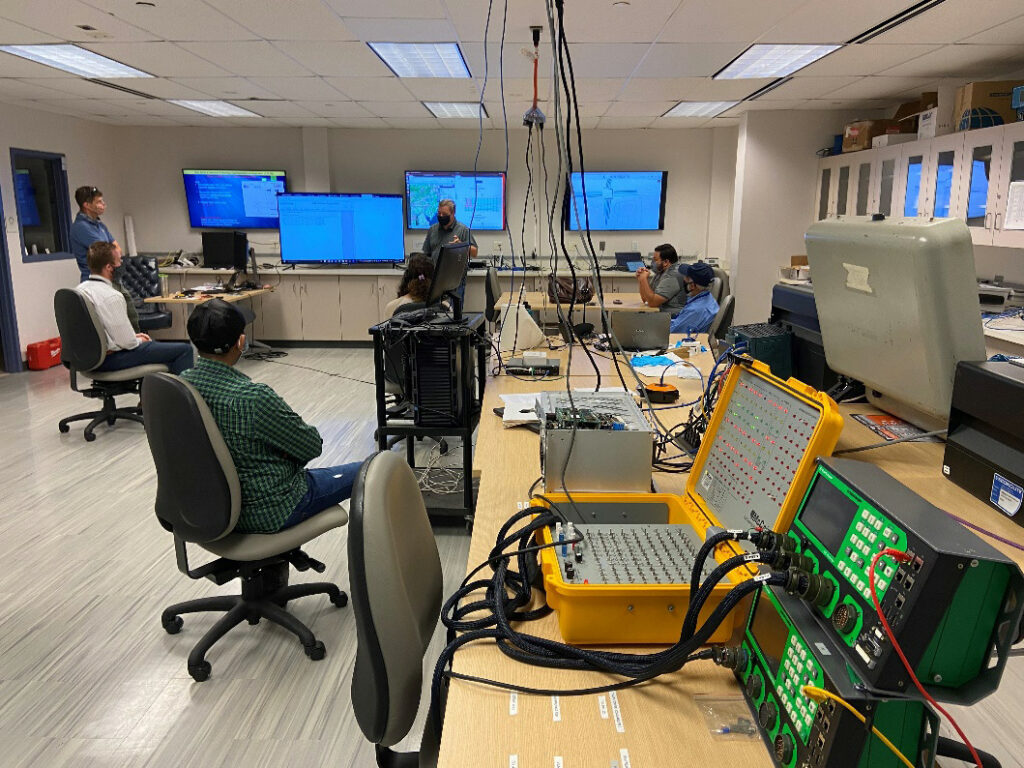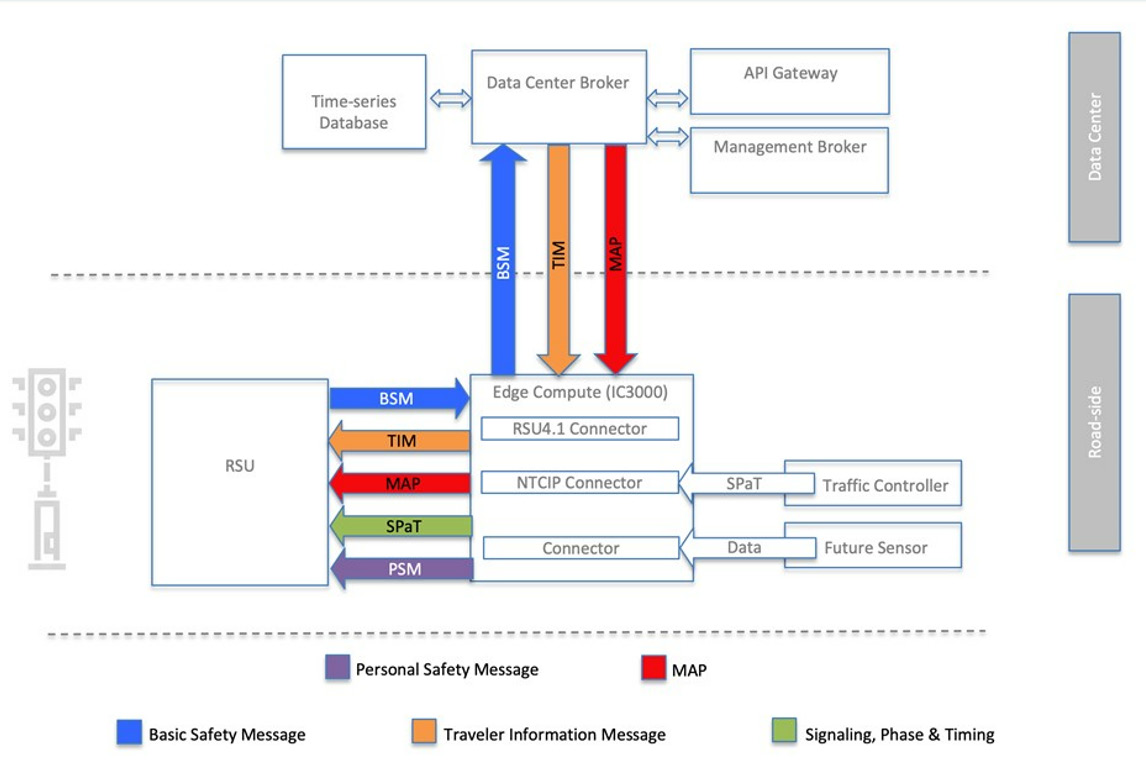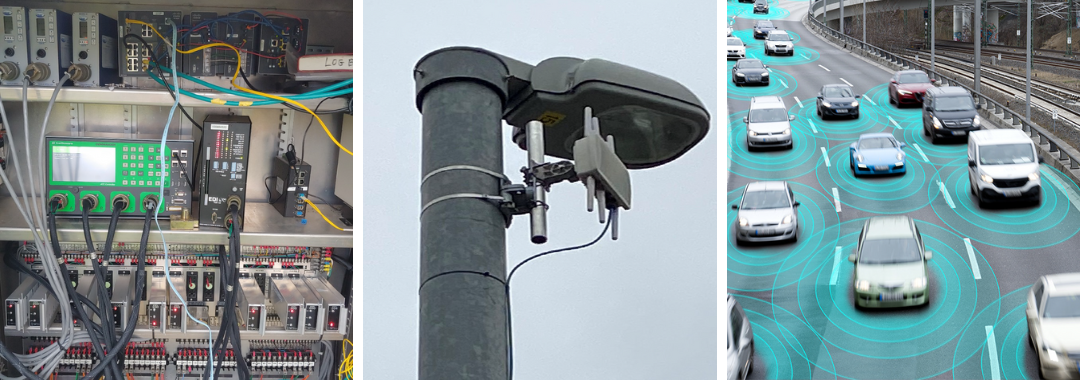Advancements in automobile technologies have prompted the New Jersey Department of Transportation (NJDOT) and other stakeholders across the nation and globe to explore the potential of Connected Vehicle systems. Connected Vehicle (CV) technology allows cars on the road to remotely communicate with surrounding digital systems, and react accordingly to ensure safety, operations and mobility benefits.
These communication networks are often divided into three broad concepts (1):
- Vehicle to Vehicle (V2V): CVs communicating with each other to alert riders or prevent potential collisions.
- Vehicle to Infrastructure (V2I): CVs communicating with road or city systems, such as stoplights, to orient and guide safer road navigation.
- Vehicle to Everything (V2X): CVs communicating with potentially any accessible device, such as a pedestrian’s phone to prevent unsafe traffic interactions.

Over several years, NJDOT has introduced several initiatives and participated in various CV-related working groups to evaluate the requirements for upgrading its digital infrastructure to support the successful deployment and integration of CV equipment into the existing NJDOT ITS architecture. From these evaluations, NJDOT determined that the best way to implement a real-world Transportation System Management and Operations (TSMO) solution would be to establish a complete CV test-bed environment with pilot field locations. This determination led to NJDOT completing its New Jersey Connected Technology Integration and Implementation (NJCTII) project. NJDOT recently drafted a case study published by the National Operations Center of Excellence (NOCoE) that describes the lessons learned from the NJCTII initiative in advancing CV technologies (2).
TSMO Planning Strategies and Deployment
As part of the case study, NJDOT noted that a thorough planning and evaluation process was required to carry out the procurement, deployment and validation processes that could lead to the enhanced digital infrastructure hardware and software required for CV technologies. NJDOT described how its efforts followed the Federal Highway Administration’s (FHWA) System Engineering Process, highlighting several key implementation steps:
- Capability Maturity Matrix (CMM): A process tool that allowed the NJCTII to prioritize the proper actions and areas of emphasis throughout the NJCTII project.
- Concept of Operations (ConOPS): A document that outlined the NJDOT’s current digital infrastructure and communications systems and identified the needs required to achieve statewide connectivity, CV data management and networking, procurement, and CV application deployment.
- System Requirements Document (SRD): A document and a new process was created to evaluate deployment locations and determine needs for CV technology implementation, such as requirements for location selection, hardware selection, data flows security, and interoperability with existing NJDOT systems. NJDOT hosted or participated in several workshops to determine the overall system requirements of the digital infrastructure and CV technologies for successful deployment.
- Solution Design Document (SDD): A document that utilized information from the SRD to design the digital infrastructure and CV systems for deployment at five pilot intersections, including wiring diagrams, networking, network equipment layout and field equipment installation.
Following this detailed TSMO implementation process, NJDOT was able to procure the hardware and software components required to complete a full CV system validation in a lab facility located at The College of New Jersey (TCNJ) before conducting installation and field testing at pilot locations.

Outreach and Communications Lessons
The case study highlights the importance of outreach and communications processes that were conducted to coordinate with key stakeholders and other transportation agencies. These processes were used to determine the goals and needs for the CV system deployment on NJ’s roadway network and to consider the operational and safety issues that could be addressed through TSMO deployment strategies for CV systems. These activities included direct coordination with other transportation agencies within NJ, CV vendor and Original Equipment Manufacturers (OEMs), along with other departments within NJDOT.
Recognizing that there were many groups within NJ that were investigating CV technologies, but that they were working independent of each other, NJDOT and the NJCTII project team organized or participated in CV topic conferences, trainings, and laboratory demonstrations to disseminate knowledge of the emerging technology. The team found that involving many stakeholders in the CV planning and development process was a useful means to improve knowledge-sharing among practitioners and organizations, avoid and minimize redundant breakthroughs, accelerate the output of R&D, and increase buy-in across organizations.

Outcomes and Benefits
The case study highlights several notable outcomes and benefits. One key benefit was that NJDOT successfully deployed and integrated CV technology for several purposes: Signaling, Phase and Timing (SpaT), Traveler Information Message (TIM), Basic Safety Message (BSM), Personal Safety Message (PSM) and MAP (i.e., messaging set to provide intersections) CV data. The NJCTII team used a spiral based testing approach in the lab to validate the CV systems. NJDOT used the lessons learned from the lab to deploy a fully functional CV system at 5 pilot intersections.
Advancing Projects Through Pipeline
A pipeline of Smart and Connected Corridor projects, which use CV technology, are at various stages of planning, design and implementation in New Jersey demonstrating the fruits of the efforts to-date (3). Earlier this year, the South Jersey Transportation Authority was awarded a $8.74 million grant for the Smart and Connected Atlantic City Expressway project (4). This project will utilize V2X and advanced intelligent transportation systems (ITS) technology to improve traffic safety and efficiency. The project is being funded via the Advanced Transportation and Congestion Management Technologies Deployment (ATCMTD) grant, a program launched through the Bi-Partisan Infrastructure Bill, that is also supporting the implementation of CV systems in at least 9 other ITS projects (4). Another notable ATCMTD recipient-project is Kentucky’s Wrong Way Driving and Integrated Safety Technology System (4), which further highlights the potential of CV and ITS systems to implement road safety controls.
With an estimated 42,000 American car crash fatalities in 2021 alone (6), CVs’ potential to save lives and reduce congestion-generating crashes warrants increased attention. Models of better cooperation and general understanding of CVs, such as NJCTII, will continue to accelerate the improvement of the technology. The NJCTII initiative offers some useful lessons for other state DOTs and organizations in its approaches to test bed and pilot field-testing; use of trainings and lab demonstrations and other events to educate staff and stakeholders on CV technologies; and the development and sharing of documents to advance technological know-how and implementation through planning, design, procurement and installation phases.
References
(1) United States Department of Transportation (2020, February 27). How Connected Vehicles Work. https://www.transportation.gov/research-and-technology/how-connected-vehicles-work#:~:text=The%20CV%20concept%20uses%20data,doing%20and%20identify%20potential%20hazards
(2) National Operations Center of Excellence (2022). New Jersey Connected Technology Integration and Implementation (NJCTII). https://transportationops.org/case-studies/new-jersey-connected-technology-integration-and-implementation-njctii
(3) Intelligent Transportation System of New Jersey (2021, April 21). NJDOT’s Smart and Connected Corridor Program. Presentation: https://docplayer.net/211213418-Njdot-s-smart-and-connected-corridor-program.html
(4) NJ Biz (2022, August 11). SJTA receives $8.7M grant for AC Expressway project. https://njbiz.com/sjta-receives-8-7m-grant-for-ac-expressway-project/
(5) U.S. Department of Transportation (2022, August 10). U.S. Department of Transportation Awards $5.14 Million for Safe Driving Technologies in Kentucky https://highways.dot.gov/newsroom/us-department-transportation-awards-514-million-safe-driving-technologies-kentucky
(6) National Highway Traffic Safety Administration (2022, May 17). Newly Released Estimates Show Traffic Fatalities Reached a 16-Year High in 2021. https://www.nhtsa.gov/press-releases/early-estimate-2021-traffic-fatalities
Additional CV, ITS, and Smart and Connected Corridor Resources
Minnesota Department of Transportation (2022). Connected and Automated Vehicles. http://www.dot.state.mn.us/automated/
DriveOhio (Accessed 2022, November 15). 33 Smart Mobility Corridor. https://drive.ohio.gov/programs/av-cv/33-smart-mobility-corridor

